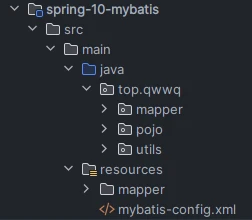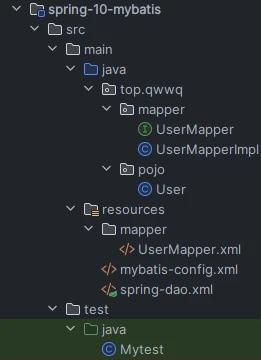Spring整合Mybatis
highlight_shrink:
aside:
abcjs:
1. 回忆Mybatis
目录结构

- 编写工具类
package top.qwwq.utils; import org.apache.ibatis.io.Resources; import org.apache.ibatis.session.SqlSession; import org.apache.ibatis.session.SqlSessionFactory; import org.apache.ibatis.session.SqlSessionFactoryBuilder; import java.io.IOException; import java.io.InputStream; // SqlSessionFactory --> sqlSession public class MybatisUtils { private static final SqlSessionFactory sqlSessionFactory; static { try { // 使用Mybatis第一步:获取sqlSessionFactory对象 String resource = "mybatis-config.xml"; InputStream inputStream = Resources.getResourceAsStream(resource); sqlSessionFactory = new SqlSessionFactoryBuilder().build(inputStream); } catch (IOException e) { throw new RuntimeException(e); } } // 既然有了 SqlSessionFactory,顾名思义,我们可以从中获得 SqlSession 的实例。 // SqlSession 提供了在数据库执行 SQL 命令所需的所有方法。你可以通过 SqlSession 实例来直接执行已映射的 SQL 语句 public static SqlSession getSqlSession(){ return sqlSessionFactory.openSession(); } } - 编写实体类
import lombok.Data; @Data public class User { private int id; private String name; private String pwd; } - 编写核心配置文件
<?xml version="1.0" encoding="UTF-8" ?> <!DOCTYPE configuration PUBLIC "-//mybatis.org//DTD Config 3.0//EN" "https://mybatis.org/dtd/mybatis-3-config.dtd"> <!--核心配置文件--> <configuration> <typeAliases> <package name="top.qwwq.pojo"/> </typeAliases> <environments default="development"> <environment id="development"> <transactionManager type="JDBC"/> <dataSource type="POOLED"> <property name="driver" value="com.mysql.cj.jdbc.Driver"/> <property name="url" value="jdbc:mysql://localhost:3306/mybatis?characterEncoding=UTF-8&useUnicode=true&serverTimezone=GMT"/> <property name="username" value="root"/> <property name="password" value="20021001"/> </dataSource> </environment> </environments> <!-- 每一个mapper.xml都需要在MyBatis核心配置文件中注册--> <mappers> <mapper resource="mapper/UserMapper.xml"/> </mappers> </configuration> - 编写接口
package top.qwwq.mapper; import top.qwwq.pojo.User; import java.util.List; public interface UserMapper { // 获取全部用户 List<User> selectUser(); } - 编写Mapper.xml
<?xml version="1.0" encoding="UTF-8" ?> <!DOCTYPE mapper PUBLIC "-//mybatis.org//DTD Mapper 3.0//EN" "https://mybatis.org/dtd/mybatis-3-mapper.dtd"> <!--namespace绑定一个对应的Mapper/Dao接口--> <mapper namespace="top.qwwq.mapper.UserMapper"> <select id="selectUser" resultType="top.qwwq.pojo.User" > select * from mybatis.user </select> </mapper> - 测试
public class Mytest { @Test public void test(){ // 第一步: 获取SqlSession对象 try(SqlSession sqlSession = MybatisUtils.getSqlSession()){ // 第二步: getMapper(方式一) UserMapper mapper = sqlSession.getMapper(UserMapper.class); for (User user : mapper.selectUser()) { System.out.println(user); } } } }
2. 整合Mybatis-Spring
官方快速上手 (👈点击这里)
方式一
代码实现
目录结构 👇
 1. 编写spring-dao.xml 由Spring来管理数据源
1. 编写spring-dao.xml 由Spring来管理数据源
-
spring-dao.xml编写DataSource,让Spring掌管数据源<?xml version="1.0" encoding="UTF-8"?> <beans xmlns="http://www.springframework.org/schema/beans" xmlns:xsi="http://www.w3.org/2001/XMLSchema-instance" xmlns:context="http://www.springframework.org/schema/context" xsi:schemaLocation="http://www.springframework.org/schema/beans https://www.springframework.org/schema/beans/spring-beans.xsd http://www.springframework.org/schema/context https://www.springframework.org/schema/context/spring-context.xsd"> <context:annotation-config/> <!-- DataSource:使用Spring的数据源替换Mybatis的配置 c3p0 dbcp druid 我们治理使用Spring提供的JDBC : org.springframework.jdbc.datasource --> <bean id="dataSource" class="org.springframework.jdbc.datasource.DriverManagerDataSource"> <property name="driverClassName" value="com.mysql.cj.jdbc.Driver"/> <property name="url" value="jdbc:mysql://localhost:3306/mybatis?characterEncoding=UTF-8&useUnicode=true&serverTimezone=GMT"/> <property name="username" value="root"/> <property name="password" value="20021001"/> </bean> <!-- sqlSessionFactory--> </beans> -
spring-dao.xml编写 sqlSessionFactory<!-- sqlSessionFactory--> <bean id="sqlSessionFactory" class="org.mybatis.spring.SqlSessionFactoryBean"> <property name="dataSource" ref="dataSource"/> <!-- 绑定Mybatis配置文件 (可要可不要)--> <property name="configLocation" value="classpath:mybatis-config.xml"/> <property name="mapperLocations" value="classpath:mapper/*.xml"/> </bean> <bean id="sqlSession" class="org.mybatis.spring.SqlSessionTemplate"> <!-- 只能通过构造器注入sqlSessionFactory,因为它没有set方法--> <constructor-arg index="0" ref="sqlSessionFactory"/> </bean> -
spring-dao.xml编写SqlSessionTemplate<bean id="sqlSession" class="org.mybatis.spring.SqlSessionTemplate"> <!-- 只能通过构造器注入sqlSessionFactory,因为它没有set方法--> <constructor-arg index="0" ref="sqlSessionFactory"/> </bean> -
UserMapperImpl.java需要给接口加实现类public class UserMapperImpl implements UserMapper{ // 在原来,我们所有的操作,都是用sqlSession,现在都使用SqlSessionTemplate private SqlSessionTemplate sqlSession; public void setSqlSession(SqlSessionTemplate sqlSession) { this.sqlSession = sqlSession; } @Override public List<User> selectUser() { UserMapper mapper = sqlSession.getMapper(UserMapper.class); return mapper.selectUser(); } } -
spring-dao.xml把UserMapperImpl.java添加到Spring的bean (可以写xml,或者用注解)<bean id="userMapper" class="top.qwwq.mapper.UserMapperImpl"> <property name="sqlSession" ref="sqlSession"/> </bean> -
Mytest.java将自己写的实现类,注入到Spring中,测试使用public class Mytest { @Test public void test(){ ApplicationContext context = new ClassPathXmlApplicationContext("spring-dao.xml"); UserMapper userMapper = context.getBean("userMapper", UserMapper.class); for (User user : userMapper.selectUser()) { System.out.println(user); } } }
小结:
需要用到的文件只有 :
UserMapper.java(接口) 用来定义方法public interface UserMapper { // 获取全部用户 List<User> selectUser(); }UserMapperImpl.java(类) 用来实现接口中的方法 👆上面有这个文件的具体代码User.java(类) pojo实体类 👆上面有这个文件的具体代码UserMapper.xml绑定UserMapper.java接口,用来写SQL语句,也可以直接使用注解来实现mybatis-config.xmlSpring整合Mybatis后mybatis-config.xml这个文件可以不需要了,但是通常还是保留,用来给类起别名、存放一些设置信息(比如日志什么的)
方式二
新建一个UserMapper的实现类,然后去继承SqlSessionDaoSupport这个类,这个类会帮你做一些步骤一的工作
public class UserMapperImpl2 extends SqlSessionDaoSupport implements UserMapper{
@Override
public List<User> selectUser() {
SqlSession sqlSession = getSqlSession();
UserMapper mapper = sqlSession.getMapper(UserMapper.class);
return mapper.selectUser();
}
}
把UserMapperImpl2类注册到Spring
<bean id="userMapper2" class="top.qwwq.mapper.UserMapperImpl2">
<property name="sqlSessionFactory" ref="sqlSessionFactory"/>
</bean>
AI小提醒:
方式二 和 方式一 的不同
SqlSessionDaoSupport和直接使用SqlSessionFactory的主要区别在于SqlSessionDaoSupport提供了一些额外的便利性,尤其是在处理SqlSession生命周期方面。
生命周期管理:当你使用
SqlSessionDaoSupport时,你不需要手动打开和关闭SqlSession。这是因为SqlSessionDaoSupport在每次请求时都会自动打开一个新的SqlSession,并在请求结束时自动关闭这个SqlSession。这意味着你不需要在你的代码中管理SqlSession的生命周期,这可以使你的代码更简洁,也可以减少因为忘记关闭SqlSession而导致的资源泄露的可能性。依赖注入:
SqlSessionDaoSupport提供了一个设置SqlSessionFactory的方法,这意味着你可以使用Spring的依赖注入功能来注入SqlSessionFactory。这使得你的DAO类和Spring框架的集成更紧密,也使得你的DAO类更容易测试,因为你可以在测试时注入一个模拟的SqlSessionFactory。模板编程:
SqlSessionDaoSupport是Spring的模板编程风格的一部分。这种风格的主要思想是将一些常见的、重复的代码(如打开和关闭SqlSession)封装在模板类中,然后让用户的类继承这个模板类。这种方式可以减少代码重复,使代码更易于维护。相比之下,直接使用
SqlSessionFactory则需要手动管理SqlSession的生命周期,也需要手动注入SqlSessionFactory。然而,这也意味着你有更大的灵活性,因为你可以控制何时打开和关闭SqlSession,也可以选择不使用Spring的依赖注入。总的来说,选择使用
SqlSessionDaoSupport还是直接使用SqlSessionFactory主要取决于你的具体需求。如果你希望代码更简洁,或者你正在使用Spring框架,那么SqlSessionDaoSupport可能是一个好选择。如果你需要更大的灵活性,或者你不想让你的DAO类与Spring框架紧密集成,那么直接使用SqlSessionFactory可能是一个好选择。
在代码层面上,使用SqlSessionDaoSupport和直接使用SqlSessionFactory的主要区别在于如何管理SqlSession的生命周期,以及如何进行依赖注入。
-
生命周期管理:当你使用
SqlSessionDaoSupport时,你不需要手动打开和关闭SqlSession。例如:public class MyDao extends SqlSessionDaoSupport { public MyObject getMyObject(int id) { return getSqlSession().selectOne("MyMapper.getMyObject", id); } }在上面的代码中,
getSqlSession()方法由SqlSessionDaoSupport提供,并且它会自动管理SqlSession的生命周期。相比之下,当你直接使用
SqlSessionFactory时,你需要手动打开和关闭SqlSession。例如:public class MyDao { private SqlSessionFactory sqlSessionFactory; public void setSqlSessionFactory(SqlSessionFactory sqlSessionFactory) { this.sqlSessionFactory = sqlSessionFactory; } public MyObject getMyObject(int id) { try (SqlSession sqlSession = sqlSessionFactory.openSession()) { return sqlSession.selectOne("MyMapper.getMyObject", id); } } }在上面的代码中,
SqlSession是通过sqlSessionFactory.openSession()手动打开的,并且在try-with-resources语句中自动关闭。 -
依赖注入:当你使用
SqlSessionDaoSupport时,你可以使用Spring的依赖注入功能来注入SqlSessionFactory。例如:<bean id="myDao" class="org.mybatis.spring.support.SqlSessionDaoSupport"> <property name="sqlSessionFactory" ref="sqlSessionFactory" /> </bean>在上面的配置中,
SqlSessionFactory是通过Spring的<property>配置注入的。相比之下,当你直接使用
SqlSessionFactory时,你也可以使用Spring的依赖注入功能来注入SqlSessionFactory,但是你需要在你的DAO类中提供一个设置SqlSessionFactory的方法。例如:<bean id="myDao" class="com.example.MyDao"> <property name="sqlSessionFactory" ref="sqlSessionFactory" /> </bean>在上面的配置中,
SqlSessionFactory是通过Spring的<property>配置注入的,但是这需要你的DAO类提供一个setSqlSessionFactory(SqlSessionFactory sqlSessionFactory)方法。

